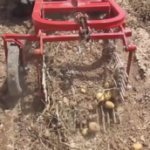 Tractor Agriculture is going to explain Secondary Tillage Implements today. Growing up in my ancestral village, I used to see different Types of Tractors and relevant tools being used in the fields by the laborers.
Tractor Agriculture is going to explain Secondary Tillage Implements today. Growing up in my ancestral village, I used to see different Types of Tractors and relevant tools being used in the fields by the laborers.
In my childhood, I was keen in seeing different tools being attached to the Tractor and then made to work effectively. I was young at that time and could not grasp the technicalities involved.
I asked my father once regarding the usage of these implements but my father ignored my question thinking of it as a childish inquiry. I used to feel bad when my questions were ignored by my father and field laborers, but that curiosity is still within me.
My years of observation and accompanying my father into the fields have given me enough confidence to showcase the rich knowledge through this blog.
Tractor Agriculture discussed a Primary Tillage Implement in the previous Article and today going to discuss secondary tillage implements in detail. The definition of these tools will be clearly explained today. You can download the pdf available at the end of this article.
These are the tools that are used for the purpose of soil preparation, soil smoothening, soil packing and removing unwanted weeds.
The basic work done by secondary tillage implements is given below:
- These tillage tools remove the weeds by cutting. They are covered, dragged out from the surface of soil and are finally killed.
- Tillage tools loosen the soil and facilitate the moisture entry into the soil.
- Tillage tools perform the smoothening and levelling process of the field.
- They break the clods and later pulverize them for efficient seed bed preparation.
- These tools cut the crop residue like straw etc and further mix them with soil for faster decomposition.
Types of Secondary Tillage Implements
Sometimes, Primary Tillage Implements are used in place of secondary tillage implements like one way plough etc. They play an important role in Agriculture.
The major secondary tillage implements are listed below:
- Harrows
They are further divided into 2 types.
i) Disc Harrow
ii) Toothed Harrow
Disc Harrow is sub divided into a) Trailing Type b) Mounted Type
- Pulverizers
- Cultivators
Secondary Tillage Implements Maintenance Tips
- Keep the secondary implements clean with regular checks.
- All nut bolts should be fully tight.
- The regular grease should be applied to the bearing after every set hours of operation.
Storage Tips:
After the season ends, keep following things in mind:
- The implement should be cleaned.
- The disc should be coated with grease.
- He frame should be painted.
- The implement should be stored under a shelter.
Pulverizers and Rollers
These secondary tillage implements have been used from the earlier times for the purpose of crushing the clods and smoothening the fields. If clods are not crushed, it pulls the clods inside the soil surface. Different types of Pulverizers or Rollers are available like corrugates type or spiked teeth type.
Cultivators
The cultivators are also called as Tillers or Tooth Harrows. The tillers are primarily used to further loosen the already ploughed land before seed is planted into the soil. Tillers are preferred choice for hard grounds.
Another very important use of tiller is that it destroys the grass and weeds by removing their roots. These weeds come out in direct sunlight and sun’s rays destroy them.
Types of Tillers
There are 2 types of basic tillers namely:
- Rigid Tine Tillers
- Springed Tine Tillers
Rigid Tine Tiller
It has a tine made out of spring steel and is fastened to a frame. It generally has 2 rows of tines fastened to the frame. The number of tines is an odd number and the most famous tillers have between 7-13 tines.
The 7, 9, 11 tine tillers are generally used in smaller Tractors having power up to 35 HP, while 13 tine tiller is used with Farm Tractors having horse power up to 50 HP.
Spring Tine Tiller
When working on the field, tillers are subjected to severe stress. Sometimes, stones on the field can break the tines. To avoid the breakage of tines, spring type tillers are used instead of rigid type tillers. These tillers are very popular nowadays.
Maintenance Tips for Tillers
Tillers are one of the very basic secondary tillage implements used by the farmers and need apt care and preservation. To manage this implement better, you need to keep few things in mind:
- The teeth of tines should be kept at equal depth. To check this posture, place the tiller on plane ground and all the teeth should touch the ground. If the teeth are touching the ground, it means they are at equal depth.
- The teeth should have sharp edges so that good penetration can be maintained inside the soil. After the grinding process, the depth should again be checked.
Secondary Tillage Implements (Download pdf)




